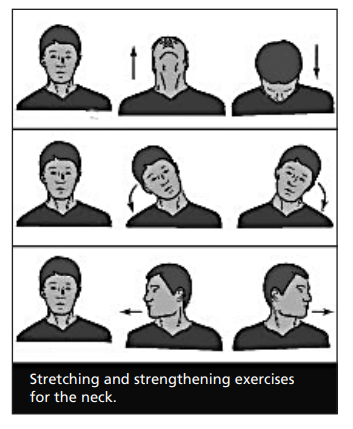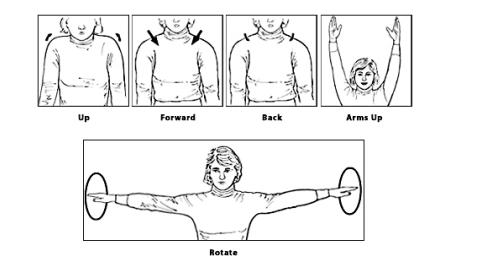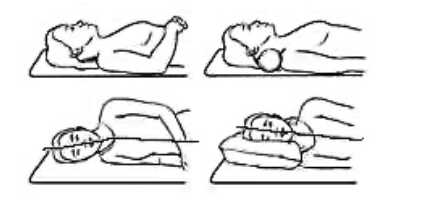This information leaflet is designed to help you understand your neck pain and to help you take positive steps towards your recovery.
The neck area
The neck (cervical spine) is composed of 7 vertebrae, between which are discs that act as shock absorbers. The bony vertebrae along with the ligaments, which are like thick rubber bands, provide stability for the neck, while muscles provide motion and give support.
What is a neck sprain?
Neck pain is common and is often the result of a car accident, but sporting injuries and falls can also be causes. The movement causing the injury is a sudden extension (backward movement of the neck) and flexion (forward movement to the neck), which is commonly referred to as whiplash. During this movement, muscles and ligaments can be stretched beyond their normal limits (sprain), causing swelling and inflammation leading to a stiff and painful neck.
Of course, suffering an accident or an injury can be traumatic and upsetting, however, most whiplash injuries are not serious. When you have neck pain, your main aim should be to keep mobile and to try and carry out your normal daily activities as much as possible. This will ensure that your neck remains supple and will allow your body’s natural healing to take place.
How does it heal and how long will it take?
Sprains heal naturally but simple treatments will make your neck more comfortable in the early stages. A mild sprain may take a week to recover but a more severe sprain may take five or six weeks or even longer. It is common for pain to reach its worst about two to three days after the injury. An x-ray is only necessary if the examination suggests the bones may have been damaged.
Until recently, the treatment for neck pain was rest and immobilisation by the use of a soft spongy collar. However, studies have shown that excessive rest can actually prolong the pain because:
- your neck gets stiff
- your muscles become weak
- you feel depressed
- the pain feels worse
- remobilisation is harder
The most important thing is to get moving again. This can be done by:
- taking the medication prescribed to you at regular intervals
- using ice packs/warm packs
- gentle exercise, such as walking or swimming
- carrying out normal activities with care
What is the treatment?
Painkillers
The aim of the painkillers is not just to ease your pain but also to relieve the spasm in the muscles which leads to a stiff neck. Paracetamol is the simplest and safest painkiller or you can use anti-inflammatory tablets, if you are able to take them, such as Ibuprofen. Do not wait until your pain is out of control. For best results you must take your medication at regular intervals as prescribed.
Heat and cold
Ice pack:
- Initially ice packs will help to reduce the pain and any muscle spasm. A bag of frozen peas wrapped in a damp towel is an ideal home ice pack. In the first 48 hours apply this to the painful area for 10-15 minutes at a time and repeat this 3-4 times daily if this helps. Be careful not to leave it on for too long or it may give you a cold burn.
Heat pack:
- After 3-4 days you may find that warmth will be more comfortable. A warm water
bottle, or an equivalent, applied as above for 15 minutes at a time, may be helpful.
Be careful that it is not too hot or you may burn yourself
Exercises
In general terms, you should progressively stretch your neck in all direction. Start by moving to the point of pain, then gradually try to go a little bit further at each session. If your pain worsens, do the exercise in a smaller range, rather than stopping altogether. Remember – little and often is better and hurt is not the same as harm. If a particular exercise makes you dizzy, try a different one. Avoid rolling your neck.
Neck stretching

You should move your neck in all directions:
- forwards and backwards
- tilt left and right
- turn left and right
Shoulder stretches

Stand relaxed and breathe evenly:
- shrug your shoulders while breathing in and then relax while breathing out.
- try rolling them whilst at the same time circle your arms, one at a time backwards and forwards like swimming the crawl or back stroke. Repeat about 10 times at least 4 times per day.
Posture
At all times, try and keep yourself in a good upright position with your back straight and your shoulders back. When sitting:
- Sit on a chair with a supportive back and firm seat.
- Ensure your hips are at the same level as your knees.
- Put a rolled towel into the small of your back and sit back against it to keep you upright.
- Avoid sitting in a soft easy chair where there is a tendency to slouch.
- Adjust your computer screen to eye level so you are not looking down into it.
Sleeping

When sleeping, use a firm mattress if possible, which will help support you better and keep your spine in proper alignment. Use pillows for support.
- You may also find it helpful to place a rolled or folded towel under your neck to support it in the correct position.
- See that the head and neck are straight and in line with the rest of the trunk. The number of pillows may be 1 or 2 or more depending on their thickness and firmness. Use the right number to keep the head and neck straight on the trunk.
- The arm on which you are laying must be kept in front of the chest, not under it or behind.
- Never sleep on your front with your head turned sideway.
When to seek further medical assistance
Please attend your nearest A&E Department if you experience any of the following symptoms:
- Disturbed vision
- Severe muscle spasm or the neck is in an abnormal posture
- Severe pins or needles
- Numbness or weakness in the arms or leg
Visit the NHS website for further information on neck pain and a stiff neck.
Please contact your GP or NHS111 for any queries or concerns.
Download the PDF leaflet: